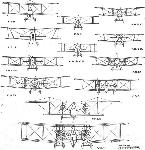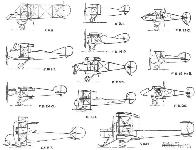C.Andrews Vickers Aircraft since 1908 (Putnam)
<...>
A further development of the Gunbus was projected in the F.B.23 for a pusher fighter of 38-ft span as a replacement for the F.B.9. This failed to materialise, but an unusual development of this design to carry the Crayford rocket gun was built in Vickers' experimental shop at Gravel Hill, Bexleyheath. This was the F.B.25, and the power unit was the 150 hp Hispano Suiza. It was intended as a night-fighter to fill the same requirement as Farnborough's N.E.1, but it was crashed by a Service test pilot in May 1917, after an unflattering flight-test report.
F.B.25 - One 150 hp Hispano Suiza. Span 41 ft 6 in; length 28 ft 1 in; height 10 ft 10 in; wing area 500 sq ft. Empty weight 1,608 lb; gross weight 2,454 lb. Max speed 86 mph at 5,000 ft; climb to 10,000 ft - 27 1/4 min; service ceiling 11,500 ft; absolute ceiling 13,500 ft; endurance 4 1/2 hr. Armament one Vickers Crayford rocket gun.
Показать полностью
P.Lewis The British Fighter since 1912 (Putnam)
Vickers suffered equally bad luck with their F.B.25 which reverted to the pusher biplane layout for a two-seat, anti-Zeppelin fighter. The broad nacelle housed two separate side-by-side cockpits, that to starboard being set in advance of the other. The rear of the nacelle contained a 150 h.p. Hispano-Suiza engine, in lieu of the intended 200 h.p. version of the same engine which was unobtainable for the machine. A single Vickers Crayford rocket gun was intended to be the F.B.25’s armament and, as an aid to night operations, a searchlight was fitted in the prow of the nacelle.
The F.B.25 made no headway as it crashed at Martlesham Heath during trials which had already disclosed that its response to its controls was very poor, causing its demise.
Показать полностью
F.Mason The British Fighter since 1912 (Putnam)
Vickers F.B.25
The resolute persistence with which Vickers continued to build derivatives of the outmoded Gunbus formula, two years after it had been shown to be thoroughly out of place in the presence of dedicated dogfighters, never fails to astonish historians, particularly when one remembers that the company had already demonstrated its ability to build promising tractor scouts in the course of those two years.
It can be argued that the Gunbus was always justified by the nature of its armament, and in the F.B.25 this was to consist of the experimental Vickers Crayford rocket gun. The aircraft was a two-bay staggered biplane, powered by a 150hp direct-drive Hispano-Suiza engine. The nacelle was fairly short, but sufficiently broad-beamed to accommodate the pilot and gunner almost side-by-side, - the gunner’s position to starboard and staggered slightly forward of the pilot. The upper wing possessed no centre section, the two halves meeting on the aircraft’s centreline; the lower wing, however, included a separate centre section, to which the V-struts of the landing gear were attached.
Being proposed as an anti-airship night fighter, the F.B.25 was intended to include a ten-inch searchlight in the extreme nose, but all available evidence suggests that this was never fitted.
The sole example underwent trials at Martlesham Heath in late June or early July 1917 but crashed, possibly while landing in a strong wind (the report on the trials stated that, owing to poor controls, the aircraft proved to be ‘almost unmanageable in a wind over 20 mph’. The serial number of this aircraft is not known, although a document, traced recently, refers to it as No ’13, and it has been suggested that this may indicate A9813 (formerly a cancelled number intended for a Sopwith Triplane).
Type: Single pusher engine, two-seat, two-bay biplane night fighter.
Manufacturer: Vickers Ltd (Aviation Department), Knightsbridge, London.
Powerplant: One 150hp Hispano-Suiza direct-drive engine driving two-blade pusher propeller.
Dimensions: Span, 41ft 6in; length, 28ft lin; height, 10ft 10in; wing area, 500 sq ft.
Weights: Tare, 1,608lb; all-up, 2,454lb.
Performance: Max speed, 91 mph at sea level, 84.5 mph at 10,000 ft; climb to 10,000ft, 27 min 10 sec; service ceiling, 11,500ft; endurance, 4 1/2 hr.
Armament: One Vickers Crayford rocket gun in nose of nacelle.
Prototype: One (believed first flown in June 1917).
Показать полностью
W.Green, G.Swanborough The Complete Book of Fighters
VICKERS F.B.25 UK
Derived from the abortive F.B.23 design intended as a successor to the F.B.9, the F.B.25 two-seat night fighter was conceived to fulfil the same requirement as the Royal Aircraft Factory’s N.E.1. Completed in the early spring of 1917, the F.B.25 carried its two crew members in staggered side-by-side seats, the gunner being positioned ahead and to starboard. Like the N.E.1, the F.B.25 was intended to carry the Vickers-built Crayford rocket gun with which it was supposed to attack hostile airships, and a small searchlight was originally to have been mounted in the extreme nose of the nacelle. The intention was to power the F.B.25 with the 200 hp Hispano-Suiza eight-cylinder water-cooled engine, and in order to minimise the risk of the aircraft turning over during a nocturnal landing, it was proposed to provide a nosewheel. In the event, non-availability of a 200 hp unit dictated installation of a 150 hp Hispano-Suiza, and neither searchlight nor nosewheel was fitted. A two- bay unstaggered equi-span biplane with tailbooms converging in elevation to meet at the rear spar of the tailplane, the F.B.25 carried its unusually wide nacelle at mid wing-gap. As well as the Crayford rocket gun, an interesting feature was the oleo-pneumatic undercarriage. Flight testing revealed poor characteristics, and when sent to Martlesham Heath in May 1917 (where it was eventually to crash), the official reports were singularly unflattering, dismissing the F.B.25 as wholly unsuited for night fighting. The following performance data were established at Martlesham Heath.
Max speed, 86 mph (138 km/h) at 5,000 ft (1 525 m), 77 mph (124 km/h) at 10,000ft (3,050 m).
Time to 6,000 ft (1 830 m), 11.9 min.
Service ceiling, 11,000 ft (3 355 m).
Endurance, 4.5 hrs.
Empty weight, 1,608 lb (729 kg).
Loaded weight, 2,454 lb (1113 kg).
Span, 41 ft 6 in (12,65 m).
Length, 28 ft 1 in (8,56 m).
Height, 10 ft 10 in (3,30 m).
Wing area, 500 sq ft (46,45 m2).
Показать полностью
J.Bruce British Aeroplanes 1914-1918 (Putnam)
Vickers F.B.25
THE Vickers F.B.25 was a two-seat pusher biplane in the same category as the Royal Aircraft Factory N.E.1. It was similarly equipped with a small searchlight in the nose and was intended to carry a Crayford rocket gun for use against enemy airships.
The most remarkable feature of the F.B.25 was the side-by-side seating of its crew; the seats were slightly staggered so that the starboard was slightly in front of the port. The nacelle was thus unusually wide. Although it was mounted midway between the wings and therefore was high above the ground, it was fitted with a nose-wheel, obviously to minimise the risk of nosing over in a night landing.
The two-bay wings were of equal span and, in accordance with Vickers practice, the upper was made in two halves which met at a central trestle-shaped cabane structure. There was a centre-section in the lower wing, and the undercarriage was attached directly to it. The tail-booms converged in elevation to meet at the rear spar of the tailplane. The fin and rudder combined to form a circular surface which was symmetrical about the tailplane.
The Vickers F.B.25 was intended to have the 200 h.p. Hispano-Suiza engine, but the only power unit which could be made available for the aircraft was a 150 h.p. direct-drive Hispano-Suiza. Thus the F.B.25 suffered the fate of most of the other Vickers types of the war period, and its performance was adversely affected by the reduction of power.
The F.B.25’s career was short and undistinguished, for it crashed while undergoing its official tests at Martlesham Heath. The following extract from the official report indicates that the F.B.25 was not a satisfactory aircraft:
“The machine was extremely slack on all controls even with the engine on, but with it off it became very dangerous, the controls having practically no effect. The machine was almost unmanageable in a wind over 20 m.p.h., and it was owing to this that the machine crashed on test.”
SPECIFICATION
Manufacturers: Vickers Ltd. (Aviation Department), Imperial Court, Basil Street, Knightsbridge, London, S.W.
Power: 150 h.p. Hispano-Suiza.
Dimensions: Span: 41 ft 6 in. Length: 28 ft 1 in. Height: 10 ft 10 in. Chord: 6 ft 3 in. Gap: 6 ft. Stagger: nil. Dihedral: 3. Incidence: 3.
Areas: Wings: upper 250 sq ft, lower 250 sq ft, total 500 sq ft. Ailerons: each 14-25 sq ft, total 57 sq ft. Tailplane: 38-6 sq ft. Elevators: 29 sq ft. Fin: 9 sq ft. Rudder: 10-25 sq ft.
Weights and Performance: No. of Trial Report: M.124. Date of Trial Report: July, 1917. Weight empty: 1,608 lb. Military load: 200 lb. Crew: 360 lb. Fuel and oil: 286 lb. Loaded: 2,454 lb. Maximum speed at 5,000 ft: 86 m.p.h.; at 6,500 ft: 84-5 m.p.h.; at 10,000 ft: 76-5 m.p.h.; at 12,000 ft: 72 m.p.h. Climb to 1,000 ft: 1 min 35 sec; to 3,000 ft: 5 min 5 sec; to 6,000 ft: 11 min 55 sec; to 10,000 ft: 27 min 10 sec; to 12,000 ft: 44 min 5 sec. Service ceiling: 11,500 ft. Absolute ceiling: 13,500 ft. Endurance: 4 1/2 hours.
Armament: The armament for which the Vickers F.B.25 was designed was a Vickers Crayford rocket gun.
Показать полностью
H.King Armament of British Aircraft (Putnam)
F.B.25. Early in 1917 Vickers turned out a two-seat pusher anti-airship night fighter in the category of the Royal Aircraft Factory and similarly armed with a "Crayford rocket gun". Originally the gun was to have been supplemented by a searchlight in the nose, but this never materialised, although the gun, or a mock-up of it, was certainly installed. The two cockpits were side by side and staggered, that for the gunner being ahead and to starboard. The gun was trunnion-mounted ahead of the cockpit.
Показать полностью
Журнал Flight
Flight, June 12, 1919.
"MILESTONES"
THE VICKERS MACHINES
The F.B. 25. (1917)
This machine was constructed at the request of the War Office to take the Crayford rocket gun for use in Zeppelin raids, and was designed for a 200 h.p. Hispano-Suiza engine, but when the time arrived to install the engine, an engine of this make, but of only 150 h.p., was allotted, the performance of the machine naturally being materially affected. It was, however, crashed by the Service pilot on its way to Martlesham in May, 1917, and as the inflammatory bullet had just been introduced into the Corps, the rocket gun was abandoned, and the machine with it.
Показать полностью







